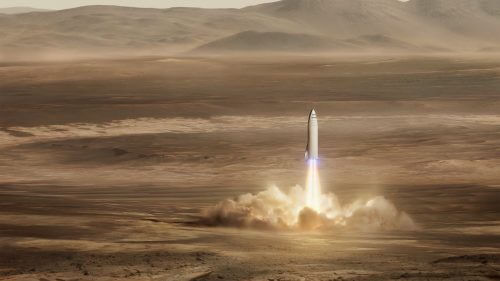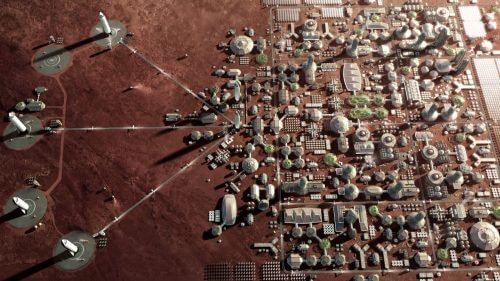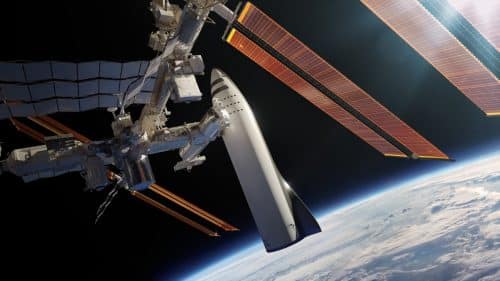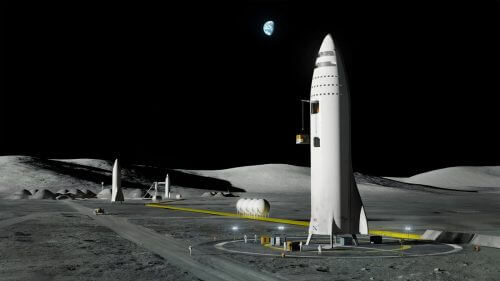Elon Musk today presented his update to the ambitious plan he presented a year ago, in which SpaceX intends to build a launch vehicle and a huge spacecraft that can carry 100 people to Mars, and turn the human race into an "interplanetary species", according to Musk.

A year ago, on September 27, 2016, the founder and CEO of SpaceX, the entrepreneur Elon Musk, Reveal the detailed plan And perhaps the most ambitious ever presented to build a manned colony on Mars. Musk's goal - turning humanity into an "interplanetary species". The vehicle that Musk presented at the time was nicknamed BFR, short for Big Falcon Rocket or Big Fucking Rocket – a fitting name for the giant launcher and spacecraft required to carry 100 people to Mars.
Today, Musk presented the first update to this plan, which the company made in order to make it more practical and economical. Musk revealed the update in a lecture at the annual conference of the International Astronautical Congress, in Adelaide, Australia.
The basic ideas that Musk presented a year ago have not changed in the updated plan, and we should perhaps refresh our memory:
- A giant launcher will launch a huge spacecraft into initial orbit around the Earth. The launcher will be reusable, and will be able to land in the launch pad from which it took off a few minutes earlier, to perform another launch at lightning speed.
- The launcher will perform additional launches of an unmanned model of the Mars spacecraft (waiting in orbit around the Earth). The unmanned model will serve as a refueling tanker, dock with the manned spacecraft in space, and refuel it. Before leaving for the journey to Mars, several such refuelings will be necessary.
- Upon arrival at the Red Planet, the spacecraft will penetrate its atmosphere using a heat shield, and then perform a vertical rocket landing.
- In order to return to Earth, the spacecraft will not need a launcher to take off from Mars. It will be able to make do with its rocket engines, this is due to the fact that the gravity of Mars is weaker than that of the Earth and its atmosphere is very thin.
- The rocket fuel for the journey back to Earth will be produced from carbon dioxide, which can be found in abundance in the atmosphere of Mars, and from water that is also found in the form of ice below the surface. Methane, the fuel the spacecraft will use, will be produced using The chemical reaction is sabbatical.
The updated plan - a smaller, but versatile vehicle

A year ago, Musk claimed that the company would be able to finance the project, thanks to the ability to fully reuse the BFR, which would significantly reduce its launch costs. Even if we assume that Musk is right, and there is room to doubt this claim, the initial development and launch costs of such giant vehicles will still be astronomical.
Musk acknowledged this problem, and said that since revealing the plan last year, he has been looking for an answer to the simple, but complicated question - how to pay for the ambitious project?
The answer, according to Musk, is to make the launcher and spacecraft slightly smaller, in order to make them useful for other missions besides the journey to Mars, such as launching commercial satellites into orbit around the Earth.
In today's lecture, Musk said: "We think we have found a way to do this, and that is to build a smaller vehicle, which will still be very large, but one that can do everything that is required in the extended environment of the Earth. In fact, we want to make our existing vehicles redundant. We want to use one vehicle, a single launch vehicle, to replace Falcon 9, Falcon Heavy and Dragon [spacecraft]. If we can do that, then all the resources allocated to Falcon 9, Falcon Heavy and Dragon can be directed to this system."
Commercial satellites will not be the only source of funding for the project - if in the future, according to Musk, the BFR will also replace the company's Dragon spacecraft, it will carry out supply missions and change crews to the International Space Station (although it is not certain that it will still exist when the construction of the BFR is completed ). The image below shows a simulation of such a task, in a way that mentions Few of the space shuttles, when they docked at the space station.

So what exactly is "smaller"? Instead of a total height of 122 meters, the BFR (spacecraft and launcher together) will "only" rise to a height of 106 meters. The diameter of the launcher will be reduced from 12 to 9 meters (for comparison, the most powerful launcher in history, Saturn 5, rose to a height of 110 meters and its diameter was 10 meters). The number of rocket engines of the launcher was reduced from 42 to 31, and the number of rocket engines of the spacecraft was reduced from 9 to 6.
The reduced system will be able to carry a payload of 150 tons to low-earth orbit. By refueling in space, the spacecraft will be able to carry all of these 150 tons to Mars (in a one-time configuration, in which the launcher has used all the fuel in its tanks and will not be able to land back on Earth, the weight of the cargo will jump to 250 tons for low-Earth orbit). Even in its reduced configuration, the BFR will be more powerful than Saturn 5, which could launch 140 tons into low-Earth orbit.
Like its initial version, the updated BFR will also be able to carry 100 people to Mars. The manned deck of the spacecraft will contain 40 passenger cabins, with 2-3 people in each cabin. The spaceship will contain, among other things, entertainment areas, a shelter from solar storms and a cargo hold. Underneath all these will be huge fuel tanks in the belly of the spaceship and the rocket engines at its base.
The updated design of the spacecraft includes Delta wing at the bottom of it. Musk stated that the company wanted to avoid this addition, but was forced to do so due to the desire to give the spacecraft the ability to land anywhere in the solar system. The rocket engines, together with the delta wing and heat shield, will allow the spacecraft to land on any planet or moon, whether it has a dense atmosphere like on Earth, a thin one like on Mars, or none at all, like on the Moon.
key components of theBFR are already in development
Musk's plan does not exist only on paper - the company has already begun to conduct experiments on various and central components of its Mars shuttle.
Last year Musk revealed a huge fuel tank measuring 12 meters and with a volume of 1,000 cubic meters. The tank is built from an innovative and light carbon fiber matrix, capable of handling the deep freeze in which the company intends to soak the rocket fuel (methane and liquid oxygen).
Watch the experiment in the innovative and huge fuel tank:
lol, SpaceX finally shows footage of the test where the Deep Cryo Liquid Oxygen tank that exploded pic.twitter.com/hhea2VNdou
- Sean O'Kane (@ sokane1) September 29, 2017
Today, Musk revealed the first experiment that the company performed on the tank, in which it brought it to the maximum pressure it could contain, and beyond, until it exploded. "We wanted to know where it would break, and we found out where it would break," laughed Musk.
Another advance the company has made over the past year is in the new engine it is developing for the BFR, known as "Raptor". This is a rocket engine that burns methane and liquid oxygen. According to Musk, the Raptor engine will be extremely efficient, with Thrust-to-weight ratio the highest ever.
Musk said that SpaceX has so far performed 1,000 seconds of test combustion with the rocket engine (see This video). In the development of space launchers, a rocket engine is one of the most problematic and complicated components available, so this is a very important advance.
Another element that is required for the implementation of the program is an extremely high launch rate. In fact, Musk said, multiple launches each day may be required if SpaceX is to realize its vision of a manned city on Mars. According to Musk, the total number of launches carried out, by all the companies and governments in the world, currently stands at about 60 launches per year. SpaceX has carried out 13 launches since the beginning of this year, a very significant market share, but still too small for the intentions of the ambitious entrepreneur. By the end of the year SpaceX plans to carry out 20 launches in total, and next year to reach 30 launches - half of the existing market share.

A number of other key capabilities form the basis of the program - docking and refueling in space, vertical landing on another planet, and the ability to carve ice on Mars and extract from it, and from the carbon dioxide in the Martian atmosphere, fuel for the journey back to Earth.
Some of these capabilities have been proven by SpaceX to one degree or another - the company made 16 successful vertical landings of the Falcon 9 in a row, and this year carried out the launch of a used space launcher for the first time in history; The company's Dragon spacecraft has shown the ability to dock with the International Space Station, but not independently so far. The improved Dragon 2 spacecraft, whose maiden flight is scheduled for next year, will already be able to perform automatic docking. Regarding refueling after docking in space, this is a separate and complex ability in itself, which the company will surely have to prove in the future; Regarding the latter ability - Musk did not provide exact details on how the company intends to mine ice on Mars.
Launching the first cargo spacecraft to Mars - in 2022
Musk said that the company plans to start building the first BFR vehicle in the middle of next year. Within five years, in 2022, the company intends to launch two unmanned BFR ships. In the next launch window to Mars, in 2024, four more ships will be launched, two of them manned. The purpose of these initial tasks, according to Musk, is to find a site with an available water source, and build the initial base, which will include, among other things, a large array of solar panels and a "factory" for fuel production and storage.
"This is not a typo, although it is ambitious," Musk said jokingly, when the presentation behind him showed the first launch target of 2022. Musk may have alluded to the fact that many times his ambitious schedules suffer delays and postponements. For example, the maiden flight of the company's new and slightly more modest launcher, Falcon Heavy, has been repeatedly delayed since it was originally scheduled to be launched in 2013 (the flight is now scheduled for this November, but further delays may cause another delay).
This is just the beginning though, for Musk. More advanced missions will begin building the first manned city on Mars, which he has previously indicated he wants to house a million people. In the end, even this huge city will not satisfy Musk, as his ultimate goal is to perform the land to Mars and turn it into "Earth 2.0".
From Shanghai to New York in 39 minutes: theBFR as an intercontinental ferry
At the end of the lecture, Musk presented one of the secondary uses that could be made with a monstrous vehicle like the BFR. Although it sounds a bit like science fiction, but according to Musk, since it will be a fully multi-purpose launcher, the BFR could be used for intra-Earth transport. If such a thing does come true, it will be possible to shorten the duration of the longest airline lines to at least half an hour.
Watch a video demonstrating this futuristic vision:
See more on the subject on the science website:
- Will Elon Musk and SpaceX establish the first human colony on Mars?
- Elon Musk: The Dragon 2 spacecraft will not be able to make a motorized landing; will soon update his plan to man Mars
- Elon Musk: There is a chance that within 10-12 years it will be possible to send humans to Mars
- Saving Mark Watney, The Technology – Chapter 1: Home on Mars / Chapter 2: Water and Air
- Buzz Aldrin: "I'm not in favor of a one-time round trip to Mars - we need to build a permanent base there"

10 תגובות
A. Ben Ner:
You are 100% right. A magnosphere is a must for full earthing and apparently Mars will not reach it. but:
A) A space colony under domes, with the possibility of independent existence, has great value (research that will contribute to future projects in the field of space settlement, an intermediate station for a further journey, backup for the human race).
b) Elon Musk (SpaceX) is only the "driver" in the space settlement project, he will not be the owner of the colony. He encourages other companies to join as investors in the colony that will be built, again under domes and an artificial life support environment. They will provide the technologies for settlement, he is just the driver.
c) The technologies he develops will be very useful for the future, for any journey in the solar system (and perhaps beyond that in the very distant future) along with future technologies and a journey to the planets of the sun with magnospheres. It's not just a Mars settlement.
Of course, alone he cannot finance a colony that has an independent existence, but he is currently developing the vehicle, it is an important piece of technology, when it is completed, other companies will be able to join the project of a space colony on Mars.
Whoever imagines Mars fully earthed, forget about it.
With the technology that exists and is visible, there will be no Mars with forests and oceans and a weather system.
For this, you need to create gravity on Mars or cover the whole thing with another protective layer that does not require gravity. These are grandiose projects that encompass a huge change of an entire planet.
I'm only optimistic about the ability to get to... and back from... Mars. But pessimistic about the ability to establish a permanent colony there, mainly because of cosmic radiation, which results from the absence of a magnetic field for Mars. The amount of water that can be extracted from the Martian soil is probably too small to sustain life for a long time.
This man (Elon Musk) is simply inspiring, I wish we could see his vision come true in our days.
Grandma and Grandpa,
Did you read the article? The intention is to colonize Mars, not just plant a flag there.
The real revolution in my opinion is if he really succeeds in producing fuel from the materials on Mars.
This will make the cargo many times more practical.
And what exactly will they do on Mars except put a flag like on the moon
Ladror - thanks for the correction.
"
"This is not a typo, although it is inspiring," Musk joked, as the presentation behind him showed the first launch target of 2022."
In fact he said it was ambitious and not "inspiring"
He used the word aspirational
Every expedition to Mars should also include an archaeologist.
As much as is needed in the country, some Israeli musk oak. One of them was sued.